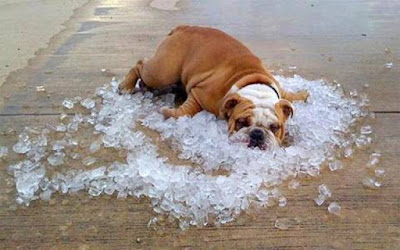The summer heat is officially here!
 While that means lots of fun activities outdoors, be sure to be extra careful when including your canine companions. Dogs can quickly suffer from “heat stroke” or extremely high body temperatures. A dog’s normal temperature is between 99-103 degrees; heat stroke occurs when body temperatures are at or above 106 degrees. When the dog overheats, the blood vessels dilate in attempt to cool the body and the heart beats faster. This leads to low blood pressure, shock, and then death of organ tissues. Treatment can be costly and may not be effective, depending on extent of damage. In one study, 50% of dogs with heat stroke did not survive despite treatment. We want to avoid this becoming an issue for your pet, so below are some tips on how to enjoy the heat safely!
While that means lots of fun activities outdoors, be sure to be extra careful when including your canine companions. Dogs can quickly suffer from “heat stroke” or extremely high body temperatures. A dog’s normal temperature is between 99-103 degrees; heat stroke occurs when body temperatures are at or above 106 degrees. When the dog overheats, the blood vessels dilate in attempt to cool the body and the heart beats faster. This leads to low blood pressure, shock, and then death of organ tissues. Treatment can be costly and may not be effective, depending on extent of damage. In one study, 50% of dogs with heat stroke did not survive despite treatment. We want to avoid this becoming an issue for your pet, so below are some tips on how to enjoy the heat safely!
- Don’t leave your pet outside during the day for extended periods of times. It is especially important that when your pet is outside that they have access to water and shade. Remember, dogs do not have the same type of sweat glands that we do, so they can only pant so much to compensate for the heat
- Don’t leave your pet confined in the sun. Many heatstroke deaths occur due to dogs being left in hot cars. It can get incredibly hot inside a car on a sunny day very quickly. It is best to leave your dog at home in the AC if you will be running errands that require you to leave them in the car.
- Be extra cautious if your animal is a breed at increased risk of heat stroke. Some breeds have a harder time panting properly to compensate for the heat. These breeds have short snouts (“brachycephalic”) and include shih tzus, bull dogs, pugs, and boxers.
- Exercise with caution! Even if your dog is usually a great running mate, try to limit exercise to cooler times of the day. Dawn and dusk are good times to consider a walk or run in the summer. The other perk is that the concrete or asphalt is not as hot at these times- remember that dogs can burn their pads when the ground is too hot!
- Dogs can get heatstroke even when swimming or playing on the beach. It’s great if your pet enjoys playing in the water, just be sure to limit their play time and give them a break in the shade or AC!
- Consider the age and health of your pet. Very young pets and senior pets may not be able to tolerate the heat as well as healthy adult dogs might. Dogs with heart or lung disease will have a harder time in the heat as well.
- Heavy/ excessive panting
- Lethargy
- Unresponsive
- Dark red gums
- Rapid heart beat
https://www.petmd.com/dog/conditions/cardiovascular/c_dg_heat_stroke
What's Next
Call us or schedule an
appointment online.Meet with a doctor for an
initial exam.Put a plan together for
your pet.

